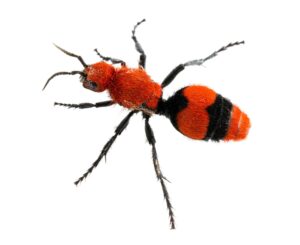Home / Blog / Detecting Invaders: 5 Signs of Carpenter Ants in House
Detecting Invaders: 5 Signs of Carpenter Ants in House

Scientifically reviewed by Rachel Maldonado
-Published on August 20, 2025
-Updated on September 17, 2025
Five Signs of Carpenter Ants in the House
Your home is a place of comfort and peace. But when carpenter ants move in, that peace can quickly turn into frustration. Of all the pests that may quietly infiltrate your living space, carpenter ants are among the most destructive, gradually compromising the structural integrity of your home.
Knowing the signs of carpenter ants in the house is essential if you want to stay ahead of a potential infestation. Below, we’ll help you understand how to spot them, what kind of damage they cause, and what you can do to stop them before the problem grows.
Appearance and Behavior of Carpenter Ants
Carpenter ants are larger than most common ants, ranging from about ¼ to ½ an inch long. They come in shades of red, black, brown, or even a combination of colors. Look for their distinct bent antennae and narrow waistline.
Unlike termites, carpenter ants don’t consume wood. Instead, they excavate it to build elaborate networks of tunnels and galleries. They prefer moist, decaying, or weakened wood, often near bathrooms, basements, kitchens, or areas with plumbing leaks. You may also spot carpenter ants inside the house in areas where sugary or protein-rich food is stored.
Worker ants do most of the foraging and tunnel-building, while winged reproductives—or swarmers—appear during spring and summer to establish new colonies.
5 Signs of Carpenter Ants in the House
So, how do you know if you have carpenter ants? Keep an eye out for these five telltale signs:
- Piles of Sawdust (Frass)
Carpenter ants push out coarse sawdust-like material—known as frass—as they hollow out wood. This mixture of wood shavings, soil, and insect parts typically gathers near the entrance to their nest, around window sills, baseboards, or wooden beams.
- Faint Rustling in Walls
In quiet settings, especially at night, you may hear a faint rustling coming from inside your walls. This is often the sound of ants chewing through wood. If you hear it consistently, it’s likely the colony is already established.
- Visible Ant Activity
Seeing a single carpenter ant indoors could mean more are nearby. These ants are often scouts, searching for food and water. If you notice them following consistent trails along walls or floors, you may already have a carpenter ant infestation.
- Swarmers (Winged Ants)
Swarmers (winged reproductive ants) emerge in spring and early summer. Spotting them indoors is a major warning sign. These ants are responsible for starting new colonies and typically only appear when an existing nest is well-developed.
- Hollow or Damaged Wood
If tapping on wooden surfaces in your home produces a hollow or papery sound, ants may have tunneled through the inside. This internal damage weakens the structure and may not be visible from the outside until it’s advanced.
Signs of Carpenter Ants vs Termites
People often confuse the two, but there are clear differences. Carpenter ants leave frass and smooth tunnels; termites build rough, mud-lined tunnels and consume the wood itself. Ants also have bent antennae and segmented bodies, while termites have straight antennae and more uniform body shapes.
The Damage Caused by Carpenter Ants
Though slower than termites, carpenter ants damage wood over time—especially in areas with high moisture. Here’s what to expect if they’re left unchecked:
- Structural harm: Ants hollow out wooden beams, joists, and supports, which can lead to serious safety concerns.
- Debris buildup: Frass is not only messy—it’s a sign of ongoing destruction.
- Weakened surfaces: Wood that’s been tunneled through loses strength and stability.
Remember, the longer carpenter ants remain, the more costly the damage becomes.
How to Get Rid of a Carpenter Ant Infestation
To fully exterminate carpenter ants, you need to eliminate both the visible ants and the hidden colony. Here’s how to start:
- Locate and eliminate moisture: Repair leaks, improve ventilation, and dry out damp areas.
- Remove food sources: Store food in airtight containers and clean up crumbs or spills promptly. (See more about what carpenter ants eat.)
- Seal up entry points: Caulk cracks, gaps, and crevices around doors, windows, and foundation lines.
- Trim vegetation: Shrubs and trees that touch your home act as highways for ants.
- Use targeted bait: While DIY methods can help, professional solutions administered by pest control experts are often more effective at reaching the nest.
How Long Does It Take to Get Rid of a Carpenter Ant Infestation?
The timeline depends on the size of the colony and its location. Minor infestations may clear up in a few days with the right treatment, while more advanced cases could take several weeks and multiple visits. The key is treating the colony itself—not just the ants you see.
How to Prevent Carpenter Ants from Coming Back
Once an infestation is under control, follow these steps to keep ants out for good:
- Reduce excess moisture in basements, crawlspaces, attics, and kitchens.
- Clean regularly, especially in food prep and storage areas.
- Inspect and seal all potential entry points.
- Schedule regular pest control to monitor and treat new activity before it becomes a problem.
Don’t Let Carpenter Ants Compromise Your Home
Carpenter ants may be quiet invaders, but their damage can speak volumes. If you’ve noticed any signs of carpenter ants in the house, now’s the time to act.
At Hawx Pest Control, our trained professionals know how to locate nests, apply precise treatments, and help you prevent future infestations. We use science-backed solutions that address your ant problem at the source—fast.
Don’t wait until the damage is done. Reach out to Hawx for a free estimate and let us help you protect your home from carpenter ants and the damage they can cause.
Related Articles
Visit our blog to learn more.
→









